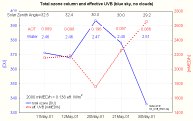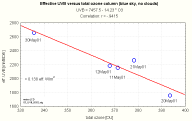


One could retain as a rough guide: 100 DU down gives about 1 MED/h up when SZA is approx. 33░
Effective UVB irradiance
and total ozone column
1997 to 2002
o3_uvb_bs.html
11Jun01 version 1.1
04Jun02 version 1.22
26 Apr03 version 1.23
francis massen
| This is a report in progress! The aim of this paper is to document the inverse relation-ship between total ozone column and effective UV irradiance, and to find an eventual change in effective UV irradiance during the last years. |
|
Abstract: |
| INDEX | 1. | Introduction |
| 2. | The relationship between eff. UVB and total ozone column | |
| 3. | Influence of O3, AOT and Water Column | |
| 4. | Variability of effective UVB during the last years |
1. Introduction
It is well known that the UVB irradiation is absorbed by the ozone gaz in the stratosphere and below: more ozone should give less UVB at ground level [6] [7]. Varotsos [3] for example found by flying an aircraft over Athens and measuring simultaneously O3 and UVR that eff. UVR increases of about 1.25 MED/h if total ozone column diminishes from 360 to 325 DU. As a general rule, the relationship between UVR and O3 is not easily found in the data, for many parameters besides O3 (as solar zenith angle, cloud cover, aerosol optical thickness, precipitable water column) have an influence on the UVB irradiance [1] [2]
2. The relationship between eff. UVB and total ozone column
The eff. UVB is measured at meteoLCD by a Solar Light Co. 501A Biometer (automatical measurements); total ozone column is measured by a hand-held Microtops II photospectrometer, also from Solar Light. The latter measurements can only be made if enough sunlight is present. In this report we will use only cloudless, blue-sky measurements done at similar solar zenith angles which eliminates much of the influences of non ozone parameters influencing eff. UVB irradiance (this is a very small subset of our measurement data)
2.1. May 2001, SZA (solar zenith angle) ~ 33░
Five blue sky days in May 2001 show the relationship between UVB and O3 in a very fine manner: these days are sufficiently close to correspond to more ar less constant solar angle (between 32.5 and 29.2 degrees), and being cloudless do represent a practically uniform atmospheric situation.The two other factors effecting UVB are essentially the aerosol optical thickness (AOT) measured at 1020nm and the precipitable water column of the atmosphere: both factors are nearly constant over these days, with one exception for a double AOT on 20th May
Click on the small graphs to get the full picture!
2.1. April 2002, SZA ~44░
We conclude that eff. UVB always anticorrelates to total ozone in blue sky conditions; nevertheless the influence of different AOT's and, to a lesser degree, different precipitable water column should be taken into account. The best anticorrelation can be found in blue sky conditions when AOT and water column are the same.
3. Influence of O3, AOT and Water Column
The 5 days of April 2002 allow to get an insight on the influence of AOT and watercolumn on eff. UVB.
| date | ozone [DU] |
eff. UVB [mMED/h] |
UVA [W/m2] |
UVB/ UVA |
total solar [W/m2] |
tot.sol/ UVB |
SZA | aerosol optical thickness | water [cm] |
| 04Apr02 | 370.7 | 1333 | 33.0 | 40.4 | 733.1 | 0.55 | 44.6 | 0.128 | 1.61 D |
| 05Apr02 | 402.9 | 1220 | 33.8 | 36.1 | 758.7 | 0.62 | 44.3 | 0.122 | 1.34 A |
| 06Apr02 | 428.0 | 1113 | 33.4 | 33.2 | 756.8 | 0.68 | 44.3 | 0.118 | 1.37 C |
| 07Apr02 | 404.3 | 1357 | 36.2 | 37.5 | 788.2 | 0.58 | 43.2 | 0.074 | 1.43 B |
| 08Apr02 | 416.1 | 1311 | 36.1 | 36.3 | 790.5 | 0.60 | 43.1 | 0.096 | 1.31 |
Lines A and B correspond to a situation of nearly same water column, same O3, but different AOT; the fraction
delta(UVB)/delta(AOT) = -2854
which means that and increase of 0.1 in AOT ( = a doubling of the usual mean value of 0.1) would diminish the UVB of 285 mMED/h.
Lines A and C correspond to nearly same water column and AOT: this time the fraction
delta(UVB)/delta(O3) = -4.26
i.e. an increase of 100 DU ( = about 20-25% of the usual values) would diminish the UVB of 426mMED/h; an hypothetical doubling of the ozone column would decrease the eff. UVB by approx. 1704 mMED/h. This shows that the variations of the O3 column are the primary cause of eff. UVB variations!.
We have too few data to analyze the influence ot water column, all other parameters being equal; the data give a hint that water column has a much smaller effect on eff. UVB than total ozone or AOT: indeed it should have none!
The influences of O3, AOT and water column follow power laws; so we will try to fit to our data the simple model
eff.UVB = K*exp(-a*O3 -b*AOT -c*Water)
Remark: Water has no absorption lines in the UV region, so it comes as a surprise that the best fit includes a water term (reducing the exponent to -a*O3-b*AOT gives an inacceptable bad fit). Does the water column measured by the Microtops include another aerosol influence? The question remains unsolved for the moment...(24Apr03)[9]
4. Variability of effective UVB during the last years
Detecting UVB changes is a difficult job: Seckmeyer [8] reports that, given the usual calibration uncertainty of about 5% of the best UVB sensors, detecting the increase resulting from a 1% ozone depletion will need a UV detection treshhold of 10-6 Wm-2nm-1; for our broadband sensor this amounts to approx. 1 - 2 mMED/h or, in term of voltage, to about 0.2 mV, i.e. close to the resolution limit of our datalogger. What follows should be read with this caveat in mind!
Our data do not allow to precisely compute the total eff. UVB dose received over a year, because the instrument was never available at 100% of the time, and some of the missing days fall in the high UVB summer days. Let us simplifiy (in an extreme manner) the problem by looking at the data from the (first occurring) blue sky days of May 1997 to 2002 (blue sky is a rare event in Luxembourg!)
| date | solar zenith angle [░] | O3 [DU] | eff. UVB [mMED/h] | eff. UVB if DU = 300 |
| 03May97 | 34.2 | 315 | 2139 | 2310 |
| 10May98 | 32.8 | 369.2 | 1814 | 2603 |
| 09May00 | 32.6 | 361.0 | 2075 | 2770 |
| 11May01 | 32.5 | 371.3 | 2154 | 2967 |
| 21May02 | 32.1 | 360.1 | 2197 | 2882 |
The Microtops II instrument does not only measure total ozone column, but also the aerosol optical thickness at 1020nm and the precipitable water column at 940nm: here are the preceeding data together with UVA (measured by a Solar Light UVA biometer), total solar irradiation mesured by a Delta_T solar sensor and the last two parameters:
| date | ozone [DU] |
eff. UVB [mMED/h] |
eff. UVA [W/m2] |
UVB/ UVA |
total solar [W/m2] |
UVB/ tot.sol |
aerosol optical thickness | water [cm] |
| 03May97 | 315 | 2139 | 39.4 | 54.3 | 989 | 2.16 | 0.096 | 1.13 |
| 10May98 | 369.2 | 1814 | 38.2 | 47.5 | 977 | 1.86 | 0.130 | 1.53 |
| 09May00 | 361.0 | 2075 | 41.5 | 50 | 914 | 2.27 | 0.135 | 2.44 |
| 11May01 | 371.3 | 2154 | 43.6 | 49.4 | 962 | 2.24 | 0.084 | 2.46 |
| 21May02 | 360.1 | 2197 | 44.6 | 49.2 | 874 | 2.51 | 0.088 | 3.15 |
The UVB/UVA blue column shows that the measured relative UVB is more or less constant; relative UVB means here relative either to UVA (UVA is not influenced by ozone, so UVB/UVA is possibly the best predictor of non ozone caused variabilty!).
During all these years 1997 to 2002, the measured solar irradiance was
practically constant (the differences in the table coming from different times
of measurement!).
An increase in eff. UVB in Europe since the end of the 1980's is documented in
paper [1] (but a significant drop has been found which started at the end of the
1970s and ended in the early 1980s); our data of May
blue sky conditions do not allow to conclude to a consistent
increase over the 6 years span 1997 to 2002.
to be continued....
References:
| [1] |
N.Y.Chubarova, Y.I. Nezval: 30 Years Variability of UV Irradiance in Moscow. Meteorological Observatory, Geographical Department of Moscaow State University, 119899 Moscaow, Russia. 2001. |
| [2] | P.N.den Outer et al: Variability of Ground-Level Ultraviolet: Model and Measurements. [Radiation Protection Dosimetry, Vol. 91 Nos. 1-3 2000: Ultraviolet Radiation Exposure, Measurement and Protection, Mc. Kinlyay,Repacholi (editors): Proceedings of an International Workshop St. Catherine's College, Oxford, England, 1999. p.105-114.] |
| [3] | C.Varotsos et al: Aircraft Observations of the Vertical Gradientof Biologically Effective UVR. Same publication as in ref.[2]; p. 161-163 |
| [4] | U.Wester: Measurements of Solar UVA, UVB and of Ozone: Estimates of Population Ultraviolet Doses.Same publication as in ref.[2]; p. 115-118 |
| [5] | G. Seckmeyer: Coordinated Ultraviolet Radiation Measurements.Same publication as in ref.[2]; p. 99-103 |
| [6] | E. Echer, V.W.J.H Kirchhoff: A Caomparision of Direct and Global UV-B X Ozone Antocorrelation. Instituto Nacional de Pesquisas Espaciais, INPE, C.P.515, S.JosÚ dos Campos, S.Paulo, Brazil. http://www.aero.jussieu.fr/~sparc/SPARC2000_new/PosterSess4/Echer/4_26/sparc4_26.htm |
| [7] | V.W.J.H Kirchhoff, E. Echer: UV-Band Ozone Anticorrelations
at Low and High Latitudes. Same address as above. http://www.aero.jussieu.fr/~sparc/SPARC2000_new/PosterSess4/Echer/4_4/sparc4_2.htm |
| [8] | G. Seckmeyer: UV Instrumentation. http://www.muk.uni-hannover.de/~seckmeyer/Instrumentation.htm |
| [9] | Chris Gueymard (chris@solarconsultingservices.com): personal communication |